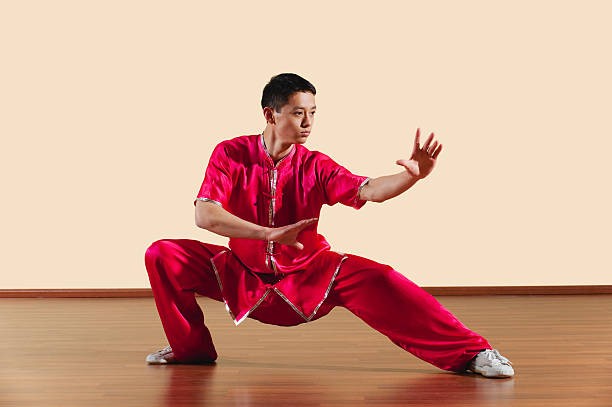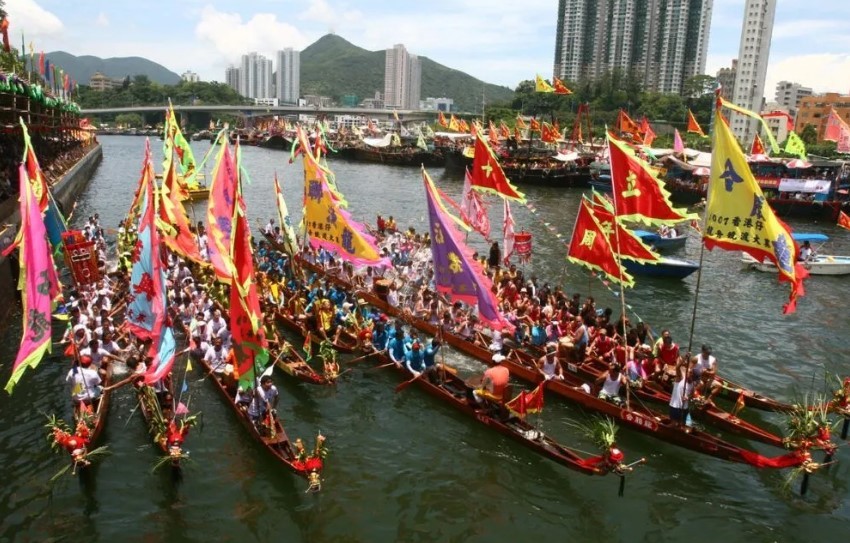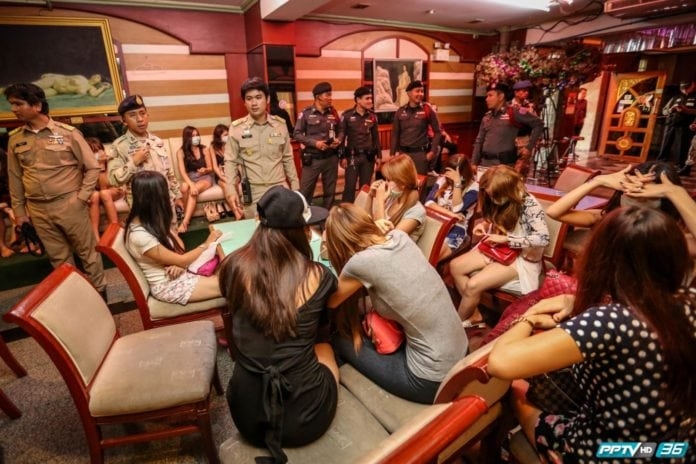What Is the Capital of China: History, Facts and Best Places to See
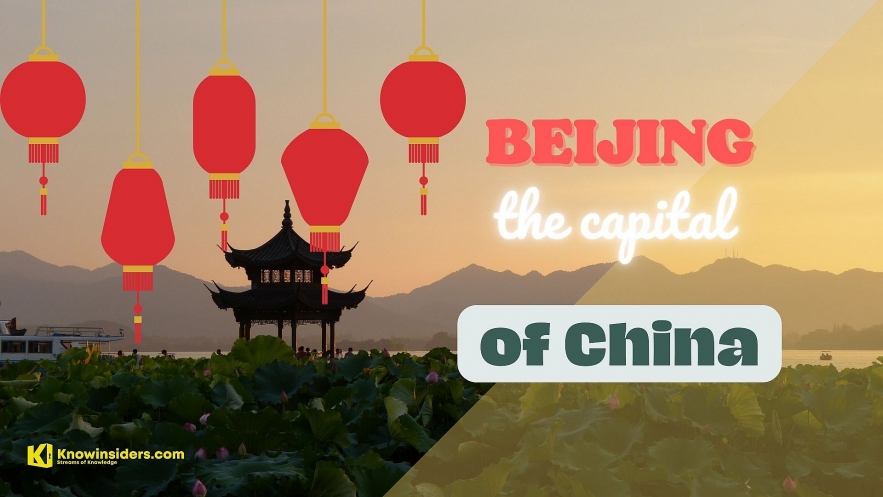 |
| What Is The Capital of China: History, Best Places to See and Facts. Photo: knowinsiders. |
What is the Capital of China?
Beijing is one of the biggest and most popular cities in the world! Over 21.5 million people live there. That's like all the people in Ontario and Quebec added together! That's a really big city.
How much do you know about Beijing? Let’s start with the basics, including history, best places to go and frequently asked questions and facts about the capital of China.
*****
History of Beijing
Beijing has a history of about 3,000 years, and it is one of the four ancient cities of China. It is one of the best-preserved ancient cities in the world, with a large number of cultural and historic legacies.
Beijing has almost continually been the capital for the last 700 years. It was the capital of six ancient dynasties, including the empires of the Yuan, Ming, and Qing that were the largest and most powerful.
According to chinaculture.com, the first traces of an urban life are from -1045 BC. At that time, the name of the city was Ji. From 476 to 221 BC, it became the capital of the kingdom of Yan. Invaded by the First Emperor Qin Shi Huangdi, it becomes in 226 BC one of the 36 prefectures of the new empire. From 916 to 1125, Beijing became the capital of the Liao. In 1153, it is the Jin Dynasty who established his capital under the name Zhongdu (the center capital). In 1215 the Mongol army, under the command of Genghis Khan, invaded Beijing and reduced it to ashes. He rebuilt it and called it Khanbaliq. The rebuilding, he renamed Khanbaliq. In 1272, his grandson, the Emperor Kublai Khan, made it the capital of the new Yuan Dynasty and given it the name of Dadu (Great Capital).
The capital was sacked in 1368 by the mercenary Zhu Yanhang who founded the Ming Dynasty. The capital is then moved to the south, at Nanjing (the capital of the south), and this until 1421 when the Ming returns to Beijing. It is in this time that the city was restructured with the construction of large building as the Forbidden City.
In 1644, the Manchus, a people of northern China, invaded China, moved to Beijing and founded the last dynasty of China: Qing.
In 1860, at the end of the Opium Wars, the Franco-British forces invaded the capital and sacked the former Summer Palace (Yuanmingyuan). In 1900, yet these are the French and the English who put fire to the new Summer Palace (Yiheyuan) to avenge the Boxer Rebellion against foreigners in China.
In 1912, the last Emperor Puyi abdicated. Chinese Republic is inaugurated by Sun Yat-sen in Nanjing. It cedes power to Yuan Shikai who transferred the republican government in Beijing. In 1916, Yuan Shikai died. This is the beginning of the period of warlords.
The Japanese army invaded Beijing in 1937 and capitulated Aug. 14, 1945. In 1949, Mao Zedong proclaimed the People's Republic. Beijing becomes the capital of the reunified China until now.
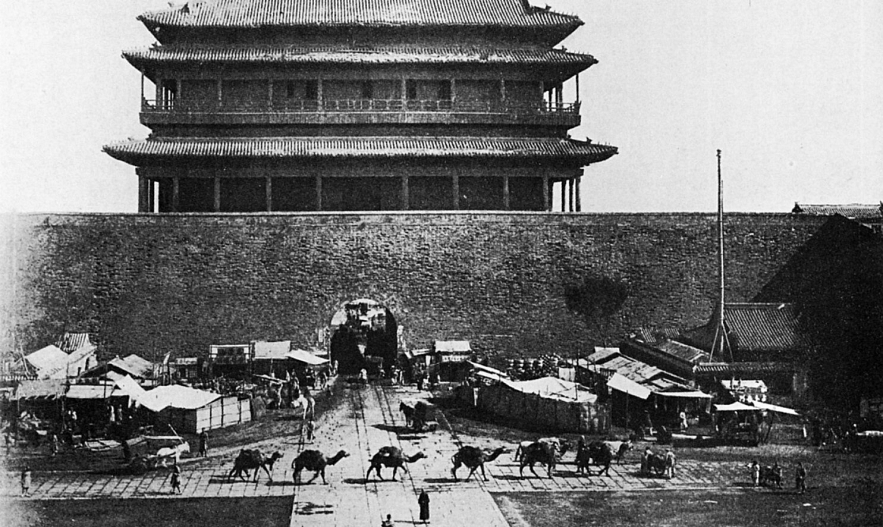 |
| Photo: beijingbyfoot |
Best Places to See in Beijing
Beijing is a mixture of both modern delights and traditional legacies of China. As a 3,000-year-old city, it retains so many historical places to visit such as the world-famous Great Wall, the grand imperial palaces and gardens. A trip to the capital wouldn't be complete without seeing the following attractions:
Forbidden City (Palace Museum)
Open: 8:30am–5:00pm Apr.–Oct.; 8:30am–4:30pm Nov.–Mar.; closed on Mondays
Recommended visit: 2 hours
Entry: CN¥60 (US$9)
The Imperial Palace, also known as the Forbidden City, is China's most significant attraction and can trace its origins back to the Yuan Dynasty of the 13th century. Its immense size is the result of enlargements made during the Ming Dynasty between 1406 and 1420, after the capital was transferred here from Nanking.
All told, this beautiful palace has been home to 24 Ming and Qing Emperors, earning its nickname of the Forbidden City due to the fact ordinary citizens weren't allowed access. The complex covers 720,000 square meters, all of it surrounded by a 10-meter-high wall with towers in the four corners and a 50-meter-wide moat. It's divided into an area used for ceremonial and administrative purposes, as well as the private quarters once used by the Emperor and his concubines.
According to planetware, highlights include the Meridian Gate, built in 1420; the Golden River Bridges, a network of five richly decorated white marble bridges; and the Hall of Preserving Harmony, which functioned as the Emperor's banquet hall.
Other places to visit include the Palace of Heavenly Purity, the largest hall in the Inner Court, and the Hall of Military Courage, a permanent residence and private audience hall for the emperors. The impressive 35-meter-high Hall of Supreme Harmony is notable as the country's largest surviving wooden building and for its splendidly decorated gilded imperial throne.
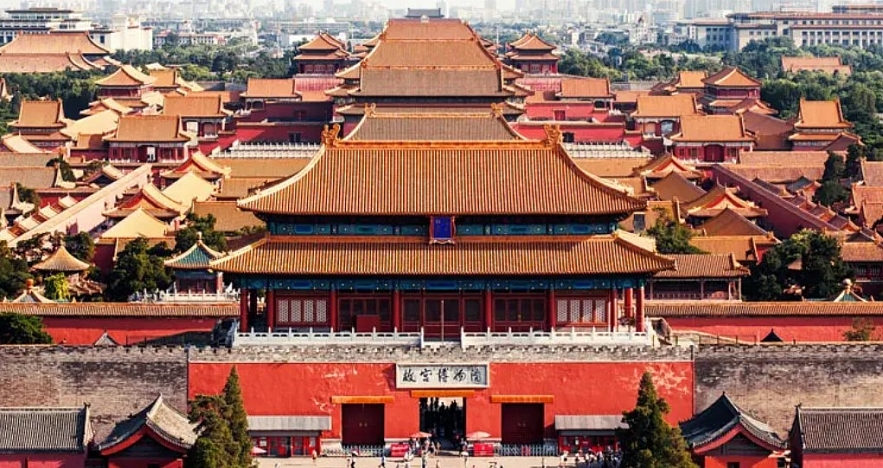 |
| Panorama of The Forbidden City. Photo: chinahighlights.com |
The Great Wall of China
“He who has not climbed the Great Wall is not a true man!”, as what was said by China’s first Chairman Mao Zedong, the Great Wall should be on every traveler’s bucket list. This China’s greatest engineering triumph, made from brick, stone, tamped earth and wood, is a direct link with legendary dynasties of China’s past as there were continuous ancient dynasties invested unquantifiable labour and material resources to construct and reconstruct the Great Wall.
Nowadays, as chinadiscovery.com reported, you can still see there are more than 5,500 miles of the Great Wall snaking its way over the perched mountainsides from the gobi desert in northwestern China to the sea coast of far eastern China. Beijing, the capital city, possesses about 573km (356 miles) of the Great Wall including the world famous Badaling, Mutianyu, Jiankou, etc., stretching alone the steep peaks and hills at its remote northern districts. You can easily plan a satisfied day trip to the closer sections of the Great Wall from Beijing. But for those who want to explore, it’s available to hike, bike even camp on some sections.
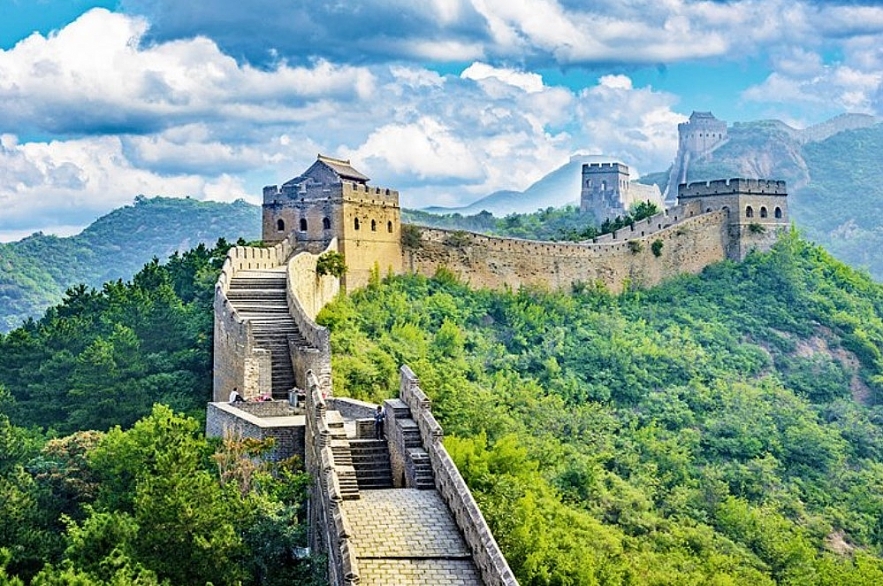 |
| The Great Wall of China. Photo: planetware.com. |
Tiananmen Square
Location: the very city center, and the midpoint of Chang'an Avenue
Travel time: 1 - 2 hours
Tiananmen Square, as the city center and one of the Beijing famous places, has witnessed many historical events.
Highlights of a visit include the Monument to the People's Heroes (Rénmín Yingxióng Jìniànbei), a 38-meter tall obelisk consisting of 17,000 pieces of granite and marble, and the splendid TiananmenGate, known as the Gate of Heavenly Peace. It was completed in 1417 and was once the main entrance to the Imperial City.
Another important gateway is Zhengyangmen, or Qianmen, the southernmost gate into Tiananmen Square. Tracing its roots back to the early 15th century and restored in the early 1900s, this imposing structure is considered one of the most important landmarks in the city.
Beijing Hutong
Beijing Hutong connecting the quadrangle dwellings is more than a tourist attraction, but also the pulse of this city. All the over 6,000 alleys of long, short, wide, narrow, straight and winding link the whole Beijing from the ancient time telling the various stories happened in each period and show the historic development and cultural change of Beijing city.
According to chinadiscovery.com, Beijing Hutong is not only a pass in this city, but also the vital stage showing the historical and cultural evolution of the ancient capital. Every tile and brick has a long history of at least over hundreds of years. For the first blink, you would think all these grey walls and tiles are the same look, but when wandering here closely in several hutongs and chatting with the local residents for a while, you could find all hutongs have their own stories and legendary experiences. Every hutong seems like a museum of folk custom with rich culture and features of era.
Beijing people have special emotion for hutong because numerous life traces are left here. And it is really meaningful to learn the daily life, delight, and neighborly relation through these diverse hutongs.
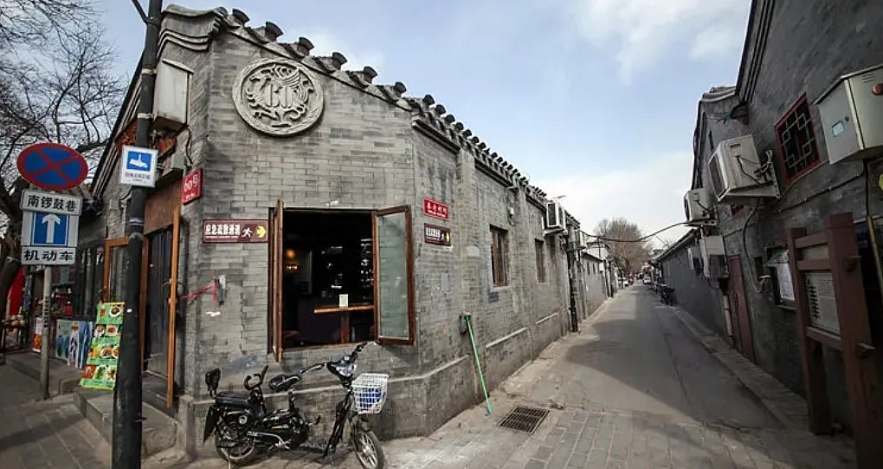 |
| Beijing Hutongs. Photo: chinahighlights |
Type: Famous Historical and Cultural Streets, Ancient Buildings, Historic Walking Areas
Best Seasons: All year round
Opening Hours: 24 hours
Tickets: Free
The Temple of Heaven
As chinaorg.cn reported, The Temple of Heaven in the southern part of Beijing is China's largest existing complex of ancient sacrificial buildings. Occupying an area of 273 hectares, it is three times the area of the Forbidden City. It was built in 1420 for emperors to worship Heaven. The principle buildings include the Altar of Prayer for Good Harvests, Imperial Vault of Heaven and Circular Mound Altar.
The Altar of Prayer for Good Harvest, 38 meters in height and 30 meters in diameter, stands on a round foundation built with three levels of marble stones. This towering triple-eave hall is under a three-story, cone-shaped glaze-tile roof in blue color crowned with a gilded knob. A circular wall of polished bricks known as the Echo Wall encloses the Imperial Vault of Heaven. The Circular Mount Altar, south to the Imperial Vault of Heaven, is where the emperor prayed to heaven. At the center lies a round stone called the Center of Heaven Stone that echoes when a visitor speaks loudly when standing on the stone.
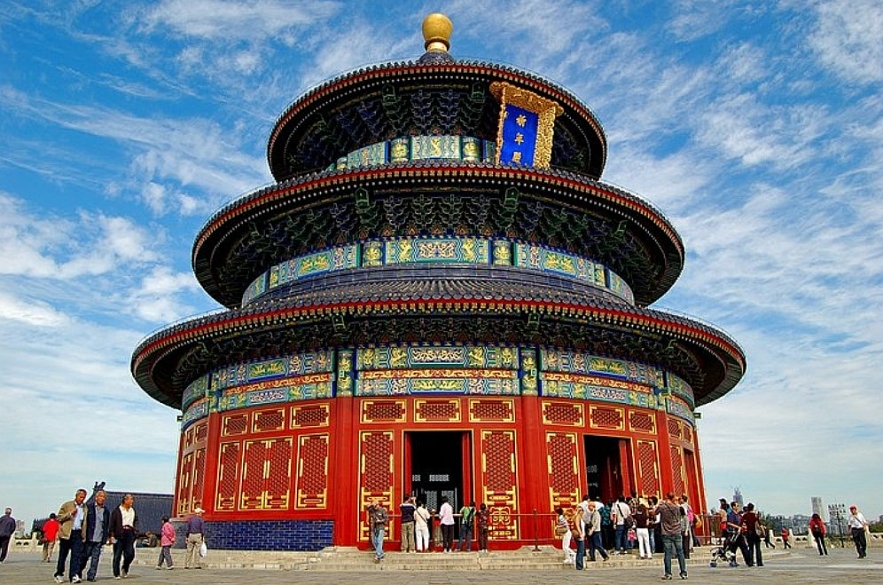 |
| The Temple of Heaven. Photo: planetware.com. |
Lama Temple
Yonghegong (‘Harmony Temple’) in Chinese, Lama Temple is one of the most famous Tibetan Buddhist lamaseries outside Tibet. Today, it is not only a museum of Tibetan Buddhism but also a functioning temple where people pray.
According to chinahightlights.com, this temple was formed from a royal palace conversion. Its buildings are a combination of imperial Qing and Tibet style. While visiting, you will not only able to get a rough understanding of Tibetan Buddhism, but also you can appreciate wonderful architecture and a variety of Buddhist statues, especially the 18-meter (59-foot) high Maitreya Buddha in Wanfu Pavilion. It was carved from one precious white sandalwood log from Nepal.
Beijing National Stadium
Recognized the world over for its role in the spectacular Summer Olympics held in Beijing in 2008, the National Stadium (Guójia tiyùchang) – also affectionately nicknamed the Bird's Nest – is well worth a visit.
As planetware reported, built with a hefty price tag, this remarkable structure owes its unique design to the influences of traditional Chinese ceramics and has, since the Olympics, been used to host large cultural events and performances including opera, pop concerts, and football matches. In winter, it's turned into the world's largest manmade indoor ski slope. (English language and self-guided tours are available.)
Sanlitun
Sanlitun Address: Between Baijiazhuang Road and Dongzhimen Wai Street in south-north, and between East 3rd Ring Road and Xindong Road in east-west.
Located in the northeast Beijing near the embassy area, Sanlitun is a fashion center gathering many shopping malls, bars, restaurants, cinemas and arts stores, etc., which is popular among young people. It is especially lively at night and a good place for night life. There are 10 vertical and 12 horizontal streets in the area now. In ancient time, it is a village three li (1,640 yards) away from the inner city, thus the name, literally a 3-li away village.
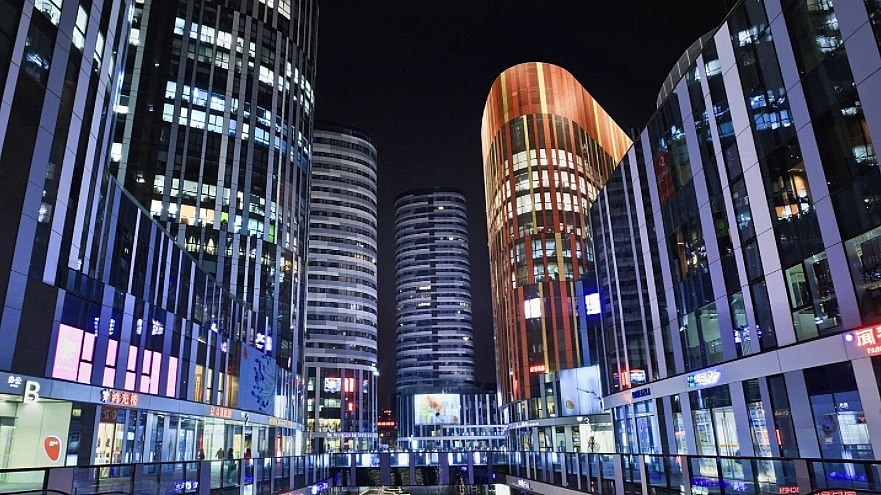 |
| SOHO Sanlitun is a new mixed commercial and residential area in Beijing, China | © TonyV3112 / Shutterstock |
Sanlitun is world-famous for Sanlitun bar street, which is the liveliest place in Beijing at night. Sanlitun Bar Street is in the east side of North Sanlitun Street, covering an area of 1,648 square meters (18,000 square feet) with a length of 260 meters (850 feet). Over 80 bars are on Sanlitun Bar Street, and more than 60 percent of Beijing's bars are gathered nearby. The most famous bars on Sanlitun Bar Street include Boys & Girls, Red Moon Club, Swing, Lan Kwai Fong, Down Town, No. 52, Day Off and so on. Some do business from afternoon to the next morning, while others are open 24 hours. But generally, their busiest time is from 21:00 to late night. Adjacent to embassy area, there are many foreigners in these bars.
Drinks available include imported wines, homemade wines, cocktails, soft drinks, and fruit juices etc. The bands would play music on the stages, the singers would sing, magicians would perform magic shows, and people would dance to relax. During major soccer tournaments, all bars on Sanlitun Bar Street place tables on the sidewalk where guests can drink, watch the game, and talk about the game.
Beijing Zoo
Located in the northwest area of the city, the Beijing Zoo (Bei jing dòng wù yuán) covers an area of more than 220 acres and was established in 1906, making it one of the oldest zoos in China.
Boasting an impressive collection of close to 15,000 animals from 1,000 species – the largest in the country – the zoo includes many rare native species such as South China tigers, snow leopards, golden snub-nosed monkeys, and pandas, along with some not so rare, such as the red-crowned crane and Pere David's deer.
Species from across the world are also well represented and include elephants, lions, and jaguars, all spread around grounds that closely resemble classical Chinese gardens, complete with dense woods, meadows, rivers, streams, and ponds, along with a number of pleasant gazebos and terraces. The zoo also has a well-stocked aquarium.
Address: 137 Xizhimen Outer St, Xicheng, Beijing
Interesting Facts about Beijing
Beijing is close to 3,000 years old
According to cbc, Beijing is older than most of the major cities in the world. Its documented history can be traced back over 21 centuries (a century is 100 years)! But there have been buildings there even longer — about 3,000 years.
It is the home of some of the most famous historical sites in the world. Here you'll find the Forbidden City and the Temple of Heaven.
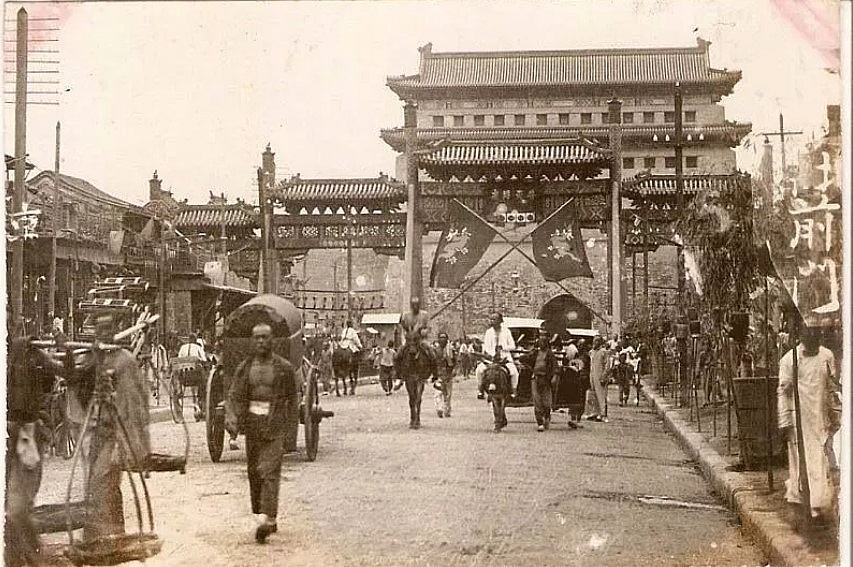 |
| Photo: china-admissions.com. |
The Largest City in China
Although it is the capital city of China, as discoverwalks reported, it is the second-most populous city in the country after Shanghai. There are about 21.71 million people in Beijing, and Shanghai though smaller has about 24 Million. Beijing, however, has more history and travel activities while Shanghai is more of nightlife, food and shopping experiences!
Beijing is arranged in rings
With the Forbidden City and Tiananmen Square at the very center, as china-admissions.com, Beijing has expanded in “rings” outward over the decades. Each “ring” is marked by a big circular road that goes around the whole city. The concept originated with Beijing tram lines that ran from the 1920s to the 1950s, where a tram that looped from Tiananmen to Gulou was called the “Ring Road” route. In Beijing, you will often hear people give directions by referencing the ring roads: “It’s out in the fifth ring,” or “I live in the third ring.”
| Beijing was the capital 6 times. Beijing is not just the capital of the modern-day People’s Republic of China. It was also the capital city five other times: 221 BC: Yan State Capital, Warring States Period 1271: first a national capital for the Yuan Dynasty 1402: Became Ming Dynasty (1368–1644) capital 1644: Qing Dynasty capital 1912: Republic of China capital |
The city of Beijing has changed its name over 15 times
Lots of big cities change their names. Cities like New York and Toronto have had different names in the past. But not as many as 16!
The city became known as Beijing in 1403. But it went through several name changes before that. It had names like Beiping (Central Peace), Dadu (Great Capital), and Zhongdu (Central Capital).
Beijing has the most billionaires in the world
The world’s wealthiest people love to live here. With 100 billionaires, Beijing beats out New York City (99), Hong Kong (80), and Moscow (79) to have the biggest uber-rich population. With so many successful Chinese companies like Huawei and Tencent, it’s no wonder!
Beijing has 197 museums
If you ever need something to do on a rainy weekend in Beijing, take a trip to one of Beijing’s 197 registered museums! This makes Beijing the city with the most museums in all of China. Museums are a great way to learn about the history and culture of Beijing: check out the popular Palace Museum or the huge National Museum of China. Or, if you have a lot of time and curiosity, take a long drive to the Manchu Folk Culture Museum, Taxation Museum, or Cinema National Film Museum.
World’s Largest Palace
The Forbidden City in Beijing is the world’s largest palace. It was the former Chinese imperial palace from the Ming Dynasty to the end of the Qing Dynasty, from 1420 to 1912.
It served as the home to Chinese emperors as well as the political and ceremonial center of the Chinese government for almost 500 years.
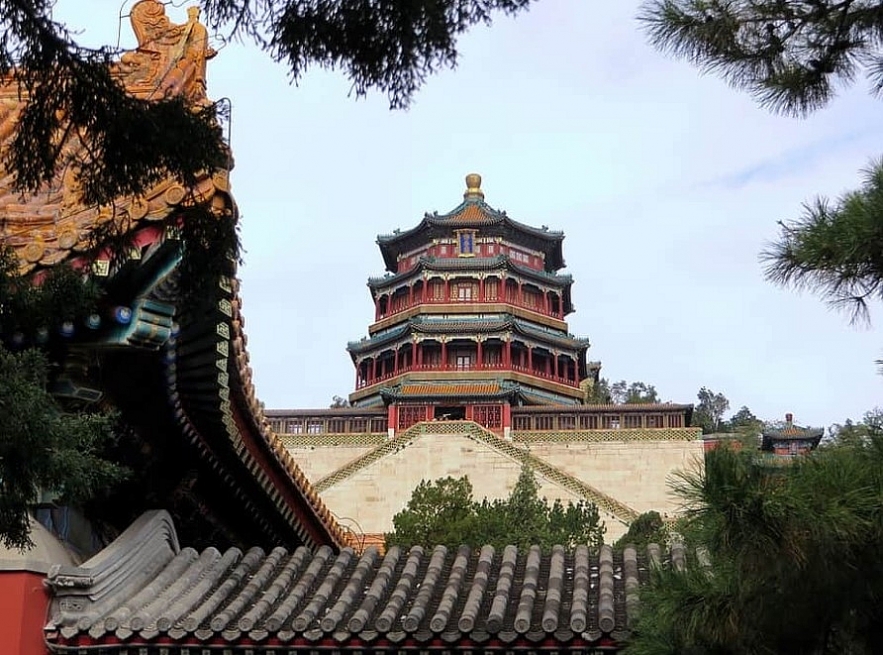 |
| Image: Pixabay |
The first KFC in China was built there
The first KFC was built in Qianmen, Beijing on November 12, 1987. The three-story-tall restaurant sold over 2,200 buckets of chicken and earned USD83,000 in just 24 hours. It continued to be extremely popular and even today, KFCs are found everywhere in China and are the most popular international fast food in China.
A few years later, McDonalds followed and opened its first store in April 23, 1992. Though McDonalds had opened a store in Shenzhen, southern China, 2 years earlier, the Beijing store was still also a huge hit. It was the largest McDonald’s in the world at that time, with seating for 700 customers. The store served 40,000 on the very first day!
Beijing is famous for opera performances
The people of Beijing really love opera! They practice singing opera in the city’s parks and opera houses (theatres). ass cbc.ca reported, opera performances in Beijing use music, storytelling, acrobatic routines and dancing. They entertain audiences and keep Chinese history alive!
| Frequently Asked Questions about China Which dish does everyone need to try when in China? Without a doubt, as abercrombiekent reported, dumplings in Shanghai. There’s a certain one, called xiao long bao, which is a steamed-soup dumpling. Inside, pork and crab is mixed with a soup broth. They are served piping hot. Scoop the dumpling onto your ceramic spoon, poke a small hole to let the soup escape, then eat the dumpling and drink the liquid – delicious. Should people consider China as a destination for a family holiday? It’s not always where you go, but what you do. We can really tailor a family trip to make it unforgettable for all generations. In Beijing, children can make a kite and fly it with a kite master; have a Chinese language lesson or a calligraphy lesson. They can go to the Peking Opera School, to be made up in traditional stage make-up. What’s some of the most unique activities to take part in? Of course, there’s tai chi, but I’d also recommend trying acupuncture or seeing a demonstration. Whichever city we’re in, we always take clients to have foot massage, which they love. And you can’t visit China without seeing a tea-appreciation ceremony to learn how best to prepare, enjoy and drink tea. When should people visit China? Autumn or spring for the best weather. From mid September to early November, depending on which region you want to visit. There’s a caveat though, never travel between the 1st and 8th of October, as all of China is on holiday. It’s the single busiest week for domestic travel. The second-best time to go is late April to mid June. |
 What Is The Capital of Belgium: History, Facts, Best Places to See What Is The Capital of Belgium: History, Facts, Best Places to See The capital of Belgium has a rich history and plays an important role in Europe, and the world. We rounded up all things you need ... |
 What Is The Capital of Australia: History, Best Places to See and Facts What Is The Capital of Australia: History, Best Places to See and Facts Australia is one of those funny countries with a capital city that is not very well known or densely populated. We rounded up all things ... |
 What Is the Capital of Canada: History, Best Places to See and Facts What Is the Capital of Canada: History, Best Places to See and Facts Canada is a hugely respected country by the rest of the world. It is seen as a place of culture, tolerance and natural beauty. We ... |

